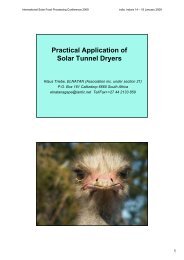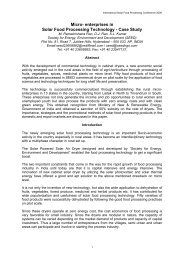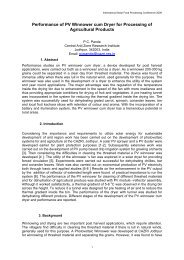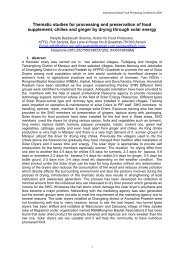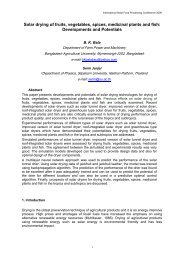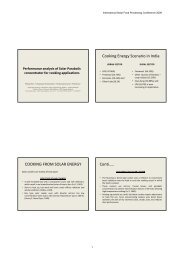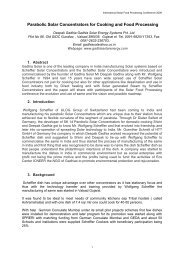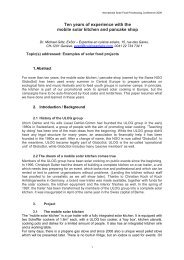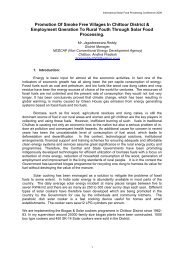Abstracts Oral Presentations - Solar Food Processing Network
Abstracts Oral Presentations - Solar Food Processing Network
Abstracts Oral Presentations - Solar Food Processing Network
You also want an ePaper? Increase the reach of your titles
YUMPU automatically turns print PDFs into web optimized ePapers that Google loves.
International <strong>Solar</strong> <strong>Food</strong> <strong>Processing</strong> Conference 2009<br />
<strong>Solar</strong> food processing in Afghanistan<br />
Dipl.-Ing. Mohammad Sabur Achtari<br />
Afghan Bedmoschk <strong>Solar</strong> Center e.V.<br />
Im Käppelefeld 37<br />
D-79189 Bad Krozingen<br />
0049-7633-949706<br />
m.s.achtari@web.de<br />
Topics<br />
Local solar food processing technologies<br />
<strong>Solar</strong> food: quality measures and indicators<br />
Examples of solar food projects: successes and hindrances<br />
1. Introduction<br />
The capital Kabul lies approx. 2300 m above sea level, on the edge of the Hindu Kush.<br />
The weather in the course of the seasons is similar to that of central Europe, only much drier.<br />
The intensive sunshine of 250 to 300 sunny days a year is a very good condition for the use<br />
of solar energy. We have established our main centre for solar food process in Kabul and<br />
from there we will enlarge our activities in all surrounding villages of Afghanistan.<br />
Preference for presentation: Power point presentation and exhibit of packed dried<br />
vegetables and dried fruits.<br />
Drying fruit and vegetables:<br />
People live on agriculture and sell the surplus of the cultivated wheat. Potatoes and onions<br />
are grown to a lesser extent. Almost no machinery is available for agriculture: ploughs are<br />
drawn by cows. In the recent years many families went over to growing fruit, as this provides<br />
a better income. The fruit is often sold directly from the trees, however for a lower price than<br />
for harvested fruit. People try to make use of the short fruit surplus during harvest time by<br />
drying apples and apricots on their roofs. To a lesser extent people dry vegetables as a<br />
winter stock. Except for drying no other methods of conservation are used.<br />
Selling the agricultural products and vegetables (fruit) results in very little income.<br />
2. Main conclusions<br />
In August 2005, a solar dryer, of a tunnel type, was built. It uses direct solar radiation. To<br />
create hot air in the collector part of the equipment with such design, a PV-driven fan<br />
provides the necessary air-flow over the fruit. It has been tested drying apricots. The<br />
handling of the drier is very similar to the traditional methods, as the fruit is simply spread on<br />
a flat surface. In this drier, 7 kg of apricots are dried within 3 to 4 days. This is very similar to<br />
the method, where the fruit is spread in open air. But the quality is much better through a<br />
23



